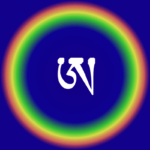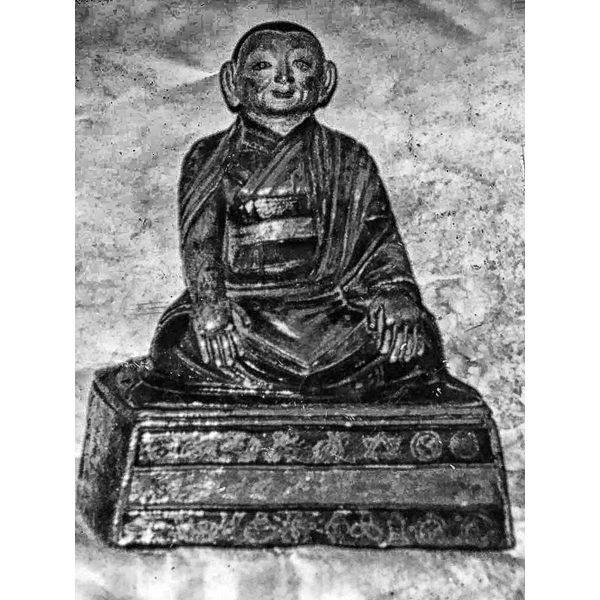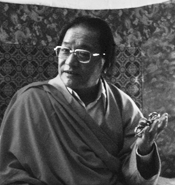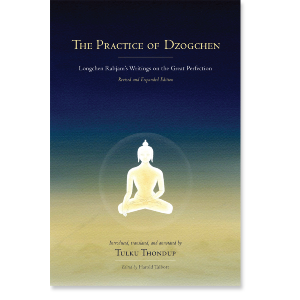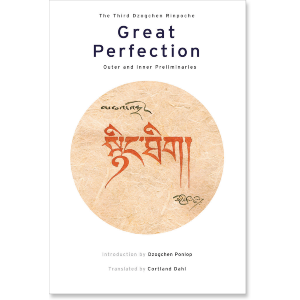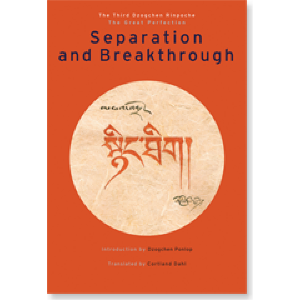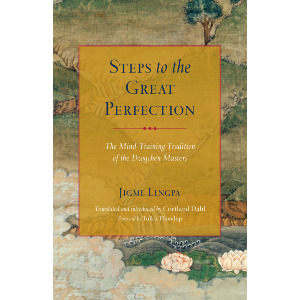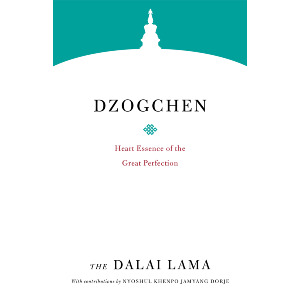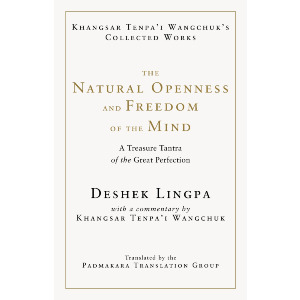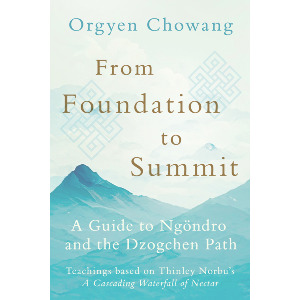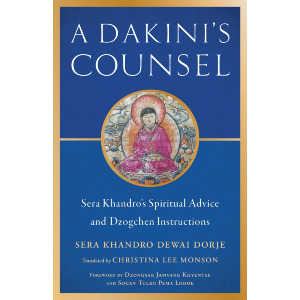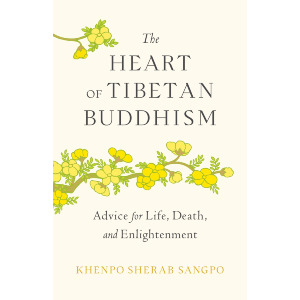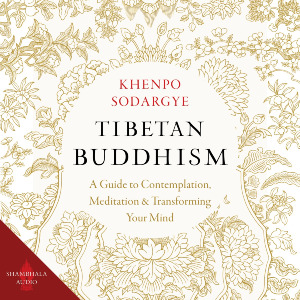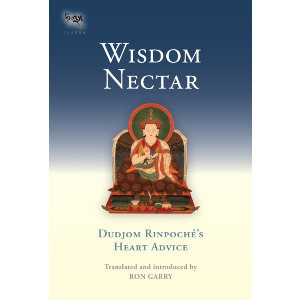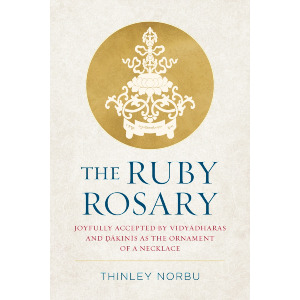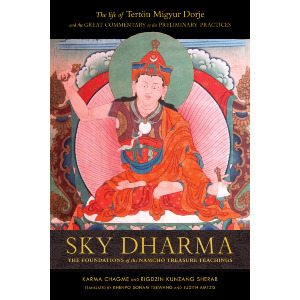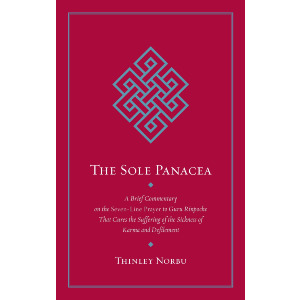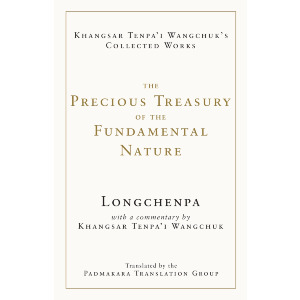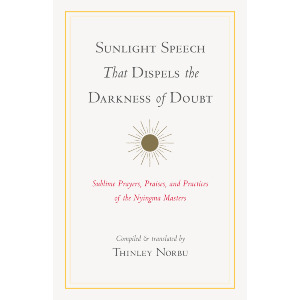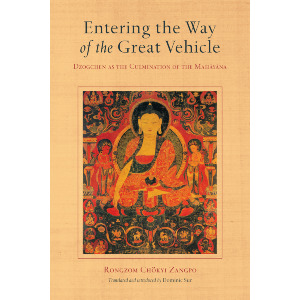| The following article is from the Spring, 1989 issue of the Snow Lion Newsletter and is for historical reference only. You can see this in context of the original newsletter here. |
The ‘Great Perfection’, or ‘Great Completeness’
The following extracts are from teachings by Sogyal Rinpoche, Rigpa Fellowship 1989.
[Dzogchen] is the already self-perfected state of our primordial nature, which needs no perfecting, for it has always been perfect from the very beginning, like the sky. It is uncreated, yet spontaneously accomplished.
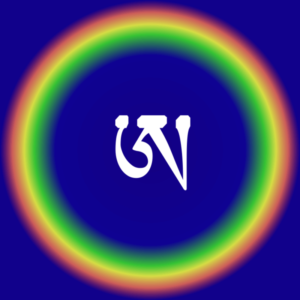
Its origins reach back to before human history, and it is limited to neither Buddhism, nor to Tibet, nor indeed even to this world of ours, as it is recorded that it has existed in thirteen different solar systems.
Dzogchen is an abbreviation of the Tibetan word "Dzogpachenpo." "Dzogpa" means "complete," or "the end," "chenpo" means great. It is widely translated as "Great Perfection," but this may imply a perfection that we strive to attain, a journey towards the goal of Great Perfection, and this is not the meaning of Dzogchen. Dzogchen is explained as Ground, Path and Fruition, and from the point of view of the Ground of Dzogpachenpo, it is the already self-perfected state of our primordial nature, which needs no perfecting, for it has always been perfect from the very beginning, like the sky. It is uncreated, yet spontaneously accomplished.
The uniqueness of Dzogchen is the way in which it brings precise experience of the awakened state, the direct experience of the absolute.
Traditionally Dzogchen can be traced to two original Sanskrit terms.
- Mahasandhi, which means the gathering of all or the quintessence, signifying that Dzogchen is the very essence, the cream and the heart juice of all teachings. Hence many of the teachings are known as "Nyingik" or "Heart Essence."
- "Atiyoga," which means "primordial yoga"; Ati indicates the topmost, summit or zenith. It has the sense of scaling a mountain, reaching the peak and having a view over everything. For Atiyoga or Dzogchen stands at the apex of the characteristic Nyingmapa presentation of the Buddhist path as Nine Yanas or vehicles, with the three inner Tantras special to the Nyingma tradition: Mahayoga, Anuyoga and Atiyoga. The zenith of all Yanas, Atiyoga represents the culmination of an individual's spiritual evolution, the point where all spiritual disciplines and paths have been traversed. The term Maha Ati for Dzogchen has also been used in recent time by masters like Chogyam Trungpa Rinpoche. . . .
The uniqueness of Dzogchen is the way in which it brings precise experience of the awakened state, the direct experience of the absolute. For in Dzogchen the main principle is to go beyond mind, to transcend the ordinary, thinking mind altogether and to reach the nature of primordial or pristine pure awareness called Rigpa, where we just rest.
As Shantideva points out in the Bodhisattvacaryavatara:
"The Absolute is beyond mind; that which is within the realm of mind is called the Relative."
the main principle is to go beyond mind, to transcend the ordinary, thinking mind altogether and to reach the nature of primordial or pristine pure awareness called Rigpa, where we just rest.
The Path
It is this that the master introduces to the student, and recognizing it is the Dzogchen View. In Dzogchen, The Path is described in terms of View, Meditation and Action, which encompass the practical training, and specifically the practice of Trekcho and the subsequent practices of Togal.
In the words of Dudjom Rinpoche:
"View is the comprehension of the naked awareness, within which everything is contained: sensory perception and phenomenal existence, samsara and nirvana. This awareness or Rigpa, has two aspects: Shunyata or emptiness as the absolute, and appearances or perception as the relative."
Within the vast expanse of Dzogpachenpo, everything there is in Samsara and Nirvana is perfectly complete. Although its Essence is empty, pure from the beginning (known in Dzogchen as "kadak"), its Nature is rich in noble qualities, pregnant with all possibilities, a vast, rich, creative field, which is spontaneously perfect (called "lhundrup").
Very simply, the Essence of mind is empty, spacious and pure from the beginning, like the open, blue sky, its Nature is luminous clarity, unobstructed and spontaneously present, like the sun with all its warmth and light, and its energy or manifestation is Compassion, unimpeded and all-pervasive, like the rays of the sun that shine on us all impartially.
The View
Introduction to the View, and resting in the state of Rigpa, is the heart of Dzogchen practice. In other approaches the realization of the nature of mind is arrived at through deduction and reasoning. In Dzogchen the actual direct experience of the state of the wisdom-mind of the Buddhas is transmitted through the blessing of a master who holds the Mind Direct transmission to students who, as a result of past aspirations and purified karma, have arrived at a point where they have both the openness of heart and devotion which make them receptive to the true meaning of the teaching.
When that powerful moment, the "meeting of mind-hearts," takes place the student has a direct and undeniable experience, or glimpse, of the nature of mind. In that instant, the master introduces and the student recognizes.
As the great Dzogchen master Patrul Rinpoche observed:
"The Nature of Mind, the face of Rigpa, is introduced upon the very dissolution of conceptual mind."
The true realization of the nature of mind is only possible when transmitted from the heart of the master to the heart of the student, and this is exemplified by the great figures of the Dzogchen lineage in the accounts of how at that moment their minds became the same as the wisdom mind of their master, for example when Garab Dorje transmitted his last testament, known as "Hitting the Essence in Three Words" to Manjushrimitra, or when Shri Singha revealed the nature of mind to Padmasambhava.
Introduction
This is why in Dzogchen the emphasis is on introduction. Dzogchen begins with introduction, because in Dzogchen there is no meditation to do separate from abiding by that View, and integrating it in action in daily life.
So, as Dudjom Rinpoche points out:
"Meditation consists of being attentive to such a state of Rigpa–free from all mental constructions, whilst remaining fully relaxed, without any distraction or grasping, because it is said that "meditation is not striving, but naturally becoming assimilated into it."
Out of the realization of the nature of one's mind radiates a deep compassion for those who have not realized, and thus in Dzogchen, meditation is described as the "radiance, or union, of wisdom and compassion."
Abiding by the continual flow of Rigpa becomes a reality and begins to penetrate the practitioner's everyday life and Action. Once the practice is truly integrated, it gives birth to a deep stability and confidence, because whatever arises, thoughts or emotions, will no longer delude one; they are liberated from their very basis. One can look into them with composure and equanimity, confident that "the Dharmakaya's efflorescence of whatever arises is neither good nor bad."
As Dudjom Rinpoche says:
"Action is being truly observant of one's own thoughts, good or bad, looking inwardly into the true nature of whatever thoughts may arise, neither tracing the past nor inviting the future, neither allowing any clinging to experiences of joy, nor being overcome by sad situations.
Fruition
This leads to the Fruition of Dzogpachenpo, which is complete enlightenment or liberation: realizing the Wisdom which is within, and on a manifest level attaining the Buddha body. Many Dzogchen practitioners have attained the rainbow body; transmuting their physical bodies into their light nature at the time of death.
Yet,
"until one attains the fully awakened enlightened state," advises Dudjom Rinpoche, "one should always value the relative aspect of phenomena and be mindful of the non-duality of appearances and their empty nature . . . . Though different forms are perceived, they are in essence empty; yet in emptiness one perceives forms. Though different sounds are heard, they are empty; yet in the emptiness one perceives sounds. Also different thoughts arise; they are empty, yet in the emptiness one perceives thoughts."
the more and more you practice, the deeper and more vast it becomes.
The practice of Dzogchen, though quite simple, is extremely profound; the more and more you practice, the deeper and more vast it becomes. In the inspiration of the teaching and with the confidence of the View in your heart, you relax into your nature and rest there.
For in Dzogchen meditation, the main point is to be as natural as possible, by releasing and relaxing effortlessly into your nature, into Rigpa. You just allow all confusion to dissolve into the absolute, and you assume the sky-like nature of mind. There is a very strong sense of loosening up, of releasing the heart and mind in deep ease and relaxation, as you enter into that state of Rigpa, in a very spacious, carefree way, without trying to do anything.
In brief, if you are not in any way contriving or manipulating, but just leave your mind in its natural state, content to be natural, that is Rigpa. When you are contriving or manipulating, that is not Rigpa. This one simple difference points to the heart of Dzogpachenpo.
The spirit of Dzogchen starts to penetrate and permeate the fabric of our everyday experience.
Absolute
Many people find that by far the most important feature of Dzogchen is its style, its attitude, and its feeling, qualities which bring tremendous relief in the ease and freedom they bring, and the absolute humor they shine onto our relative reality. The profoundness of the Dzogchen teaching lies in its tremendous clarity and vividness, its power to resonate the Truth, as a living, vital experience.
In fact for someone who has the natural disposition or karmic inclination, just to hear about Dzogchen can inspire the View. For Dzogpachenpo itself is not just a teaching, but a state, the absolute state. The teaching is a means, and a very powerful one, which links the absolute with the conditioned and relative.
Yet the wonder of Dzogchen is that it does not stain the absolute with concepts, but still speaks of it in conventional terms, bringing the Truth here into this world, and into our lives, even before we become completely enlightened. The spirit of Dzogchen starts to penetrate and permeate the fabric of our everyday experience. Even though we may be imperfect at this point, we can begin to glimpse our perfectness.
All the Buddhas are embodied within us, complete–that is why it is called Dzogpachenpo! They are already there, so there is no need to go out looking for them elsewhere.
That would be, just like Patrul Rinpoche said,
"to leave your elephant at home and go out searching for its footprints in the forest."

